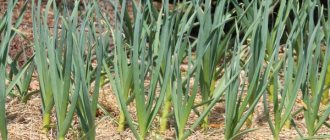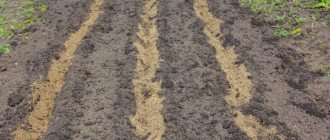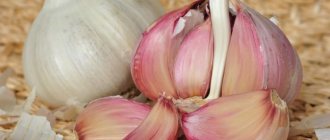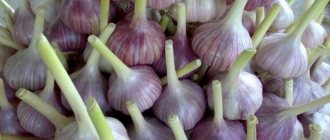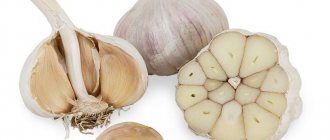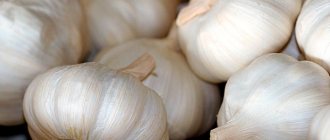Garlic is a resilient and unpretentious plant, but to successfully grow healthy produce, certain conditions must be met. The correct choice of planting site and predecessor allows you to rationally use the potential of the soil and prevent the development of diseases.
The superficial occurrence of garlic roots promotes the active use of fertilizers and minerals after plants with a root system located at depth. In addition, it is necessary to avoid repeated planting of garlic in the same place, as well as after crops that spread similar diseases.
The feasibility of observing crop rotation
- Alternating crops on a site can significantly improve the conditions for their cultivation without additional costs.
- Plants of the same family prefer the same nutrients, consume them as much as possible from the soil, and themselves saturate the soil with similar elements.
- The more diverse plants are included in the crop rotation, the less often the crop returns to its original place, and the pathogens of its characteristic diseases do not accumulate in the soil.
- Crop rotation also takes into account the beneficial effects of groups of plants on each other, which by their presence improve growing conditions.
Another factor that must be taken into account when drawing up crop rotation is the creation of normal illumination. Tall, bushy plants located in close proximity to low-growing ones create shade and inhibit the development of neighbors.
Why is it important to follow the rules of crop rotation?
Crop rotation is the alternation of different crops (vegetables, herbs) in the garden . This technology is an excellent assistant for growing tasty and healthy vegetables, berries, and herbs. It is necessary to plant various crops according to crop rotation rules for several reasons:
- Proper alternation not only prevents soil depletion, but also saturates the soil with useful substances.
- Crop rotation prevents the accumulation of pathogens and pests.
- Improves the weed situation.
- Helps maintain the normal condition of the soil, helps it become healthier.
- Different crops consume nutrients in different volumes and from different layers of the soil (some from the lower, some from the upper), so proper rotation allows you to maintain the optimal amount of nutrients in the soil.
- When choosing a bed with the right predecessors, you can save your resources and time, because you don’t have to waste energy on fertilizing and fertilizing, treating diseases and pests.
Below you can study the table of crop rotation of popular vegetable crops:
If you plant one crop in one place for several years, this can lead to unpleasant consequences: soil depletion, accumulation of pathogens, and pest invasion. But you need to change the crops in the beds wisely.
Video: features of crop rotation of vegetable crops.
Which crops to choose as a predecessor
Like other plants, garlic has its own preferences, both regarding neighbors and predecessors.
Here are some of the most favorable predecessors, after which it is better to grow garlic.
Cabbage
Early varieties of cabbage and cauliflower are suitable as predecessors for two reasons:
- The growing season ends early, which allows for complete soil preparation. This circumstance is especially relevant for planting garlic before winter.
- A good addition of organic fertilizers is applied to the cabbage. Early varieties of cabbage do not have time to fully use organic matter, but for garlic its residual amount is most acceptable.
Green manure
Early vacated areas of previous crops are sown with green manure crops to saturate the soil with useful substances. These are grain crops and forage grasses: alfalfa, clover, bentgrass, timothy grass. They improve the soil structure during decomposition and promote the accumulation of nitrogen. It is not recommended to use only rye and barley as grain predecessors.
Advice! Mustard is considered one of the best green manures; it not only nourishes the soil, but also disinfects it.
Another significant advantage of green manure is the fight against weeds, the development of which is inhibited by the main crop. Green manure is buried in the soil during the main cultivation period for planting garlic before winter or autumn digging for spring planting.
cucumbers
During the short growing season, cucumbers also do not have time to use the organic nutrition added to them. Since fresh organic fertilizers are contraindicated for garlic, one full-fledged dressing contributes to the good development of both the main crop and the subsequent one.
Zucchini, squash and other pumpkin crops
They are good predecessors not only because optimal doses of organic fertilizers are applied to them, but they do not have common diseases with garlic.
Early potatoes
It is not the best predecessor due to the fact that it spreads fusarium and nematodes, and also carries away a lot of nutrients with the harvest. For the same reasons, you should not choose other nightshades as a predecessor: tomato, eggplant. However, early potatoes free up the sown areas early and after using green manure, planting garlic is quite acceptable.
Peas, beans, beans
The best predecessors because, like all legumes, they contain bacteria in the root system that produce nitrogen. Their powerful root system significantly improves the structure of even heavy, loamy soil, and, by loosening it, helps improve oxygen supply.
Planting "fertilizers"
Green manures are fertilizer plants. They allow you to restore the normal balance of the soil, replenishing it with nitrogen, and almost completely destroy weeds; the soil becomes loose and capable of “receiving” new seedlings. In fact, having planted green manure in July, by autumn, or rather by September, you can already have a completely prepared plot of land for planting new crops. Such plants include mustard, rye, rapeseed, and green peas.
Unwanted Precursors
Among the crops not recommended as a precursor to garlic are root vegetables, various types of onions and spices.
Carrots, beets, potatoes, radishes
They intensively use nutrients, depleting the soil. Since it is not possible to replenish the lack of nutrition with organic matter immediately before planting garlic, you should not use them as predecessors. It is better to apply organic fertilizers after them to other crops and give the soil a rest.
Greenery
Onions, celery, lettuce, and spinach accumulate many microorganisms in the soil - parasites that worsen growing conditions. After all types of onions, the soil can be infected with a nematode and planting garlic after such a predecessor can not only suffer, but also die.
Turnip
A cruciferous, early-ripening root crop that does not improve soil fertility.
Spices
Cilantro, parsley, mint, basil, and coriander inhibit the development of garlic and worsen its aromatic properties.
Conditions for joint cultivation
Since both garlic and tomatoes are light-loving plants, they will both need to be provided with a sufficient amount of light. Also, both plants need dry and warm air, so when growing in a greenhouse, you need to ventilate it regularly. You should not forget about watering, but there should not be too much water, as in this case the garlic may begin to rot and deteriorate its taste. It is better to water tomatoes at the root. Fertilizers will also come in handy.
We have sorted out the conditions. Now we can talk about planting plants.
Garlic as a precursor for other crops
Winter garlic is harvested quite early, and to prevent weeds from settling in the area, it needs to be occupied with a new crop.
Strawberries and wild strawberries feel especially good in areas after garlic; they are protected from diseases for the next 2-3 years.
You can sow greens and herbs, but subject to regular watering. If you plan to use the site only next spring, it is worth sowing crops - green manure: grains, legumes, which are subsequently plowed into the soil. White mustard will fertilize the soil very effectively. If you mow it, add urea and plow it, next year the soil will be ready for planting any vegetables except cabbage.
Green manure can also be used after harvesting spring garlic.
What can you plant after garlic?
The spicy vegetable is quite unpretentious and does not require much effort to grow it. It is important to choose the right place to plant. The area should be open to sunlight. The beds must be made convenient for processing and high so that water does not accumulate. If there is enough organic fertilizer in the soil, you will get exactly the harvest you were hoping for.
After harvesting, the land must be treated with a solution of potassium permanganate or copper sulfate. Then do deep plowing and apply fungicides ( agents to combat pathogens of bacterial, viral and fungal diseases) and insecticides that destroy harmful insects. After this, other crops can be planted on the prepared and pest-free area.
It is recommended to plant annual herbs, cucumbers, legumes, and winter wheat in the vacant bed.
Garlic alternates especially well with cucumbers: both crops are guaranteed high yields.
As long-term observations of plant growers show, umbrella plants (dill), as well as strawberries, will produce good shoots in the former “garlic” plot. And so that the land does not become empty between plantings, you can sow wheat, rye or mustard on it in winter.
Important ! If the size of the plot allows, then the soil after garlic should be allowed to rest for at least 2 years.
Predecessors for planting in a garden bed before winter: after what to plant garlic?
In order to have time to prepare the soil for planting garlic before winter, early ripening crops that end the growing season early are chosen as a predecessor. After some of them, you can have time to sow green manure, since the time for planting before winter does not begin until the end of September.
Attention! Precursors are selected according to the general principle: what is not recommended for spring garlic is also not suitable for winter garlic.
The best predecessors for planting in the garden before winter: from grains - wheat, from legumes - beans, peas, from pumpkins - zucchini. It is allowed to plant winter garlic after cucumbers, early potatoes, other grains, legumes and pumpkins. The main thing is that the timing of harvesting these predecessors allows the soil to be prepared at the optimal time and the planting dates to be met.
What is the compatibility of tomatoes and garlic
Of course, the very first thing on which the growth of vegetables depends is the soil. Winter garlic grows well on light sandy loam soils. At the same time, spring garlic prefers light and medium loamy soils.
But tomatoes grow well in light sandy and loamy soils. Therefore, tomatoes go well with garlic. However, a good harvest can only grow on soils with a high content of nutrients.
Therefore, the soil must be fertilized and it is better to do this in the fall. I wrote about proper soil fertilization in a material called “How to increase soil fertility in your garden.”
Let me remind you that you need to apply organic and mineral fertilizers. Of the organic fertilizers, I prefer humus. I also add one of the best potassium-phosphorus fertilizers - wood ash.
Favorable neighborhood
Many cultures, when properly positioned, can have a significant impact on each other’s development. Garlic itself has a large number of biologically active substances, fungicides that kill infections and various microbes, and have a positive association with other plants:
- Protects potato plantings from the development of late blight and attacks by the Colorado potato beetle.
- Repels pests from planting strawberries, wild strawberries, currants, and raspberries.
- Helps suppress infections and fungal diseases of salads and spicy greens, cucumbers.
- The smell of garlic is not tolerated by the carrot fly, so rows of carrots are alternated with garlic plantings.
- Mutual benefits from proximity to tomatoes - garlic protects against rust, tomatoes - against scab.
Despite the beneficial effect, the distance between neighboring crops should be maintained at least 55-65 cm.
Garlic can have a depressing effect on a number of crops, such as legumes, perennial onions, and cabbage.
Proper organization of the garden area, alternation of crops, selection of good predecessors and neighboring crops will help increase productivity and improve product quality without additional labor costs and financial investments. Therefore, before you get started, it’s worth planning how to plant garlic and what place to give it in the crop rotation.
Eligible Followers
In order for planting tomatoes, cucumbers, carrots or any other vegetables to be successful next year, immediately after digging up the crop, the land must be prepared for the new season - dug up, treated with copper sulfate, fungicides and insecticides, and filled with fertilizers. Only after this can you decide which vegetable or berry to plant. The following crops can be successfully grown:
- tomatoes,
- beets,
- cabbage
Planting vegetables from the nightshade, cabbage and amaranth families will give a stable, good harvest. You can “scatter” dill on the same bed with them. And although the principle of “planting tops after roots” is not followed when it comes to beets, the main thing is that they and garlic “feed” differently, since they belong to different families.
There are representatives of the same family, some of which are “roots”, and others “tops”. In this case, first of all, the principle of belonging to one family is taken into account. For example, you cannot plant dill after carrots, as a representative of Umbelliferae.
Garlic has a special “relationship” with potatoes. He can become infected with fusarium from potatoes. But early varieties of potatoes only get healthier after garlic and onions.
Planting garlic in spring
There are also several requirements for planting spring varieties of garlic:
- before planting, the ground must be treated with a steep solution of table salt;
- lower the garlic no deeper than 2 cm, bottom down;
- there should be 10-15 cm between the holes;
- As soon as the first shoots appear, it is recommended to feed the garlic with ammonium sulfate, repeating in the middle of the first month of summer.
For normal growth of spring varieties, a positive ambient temperature is required, otherwise there will be no normal formation of the bulb.


